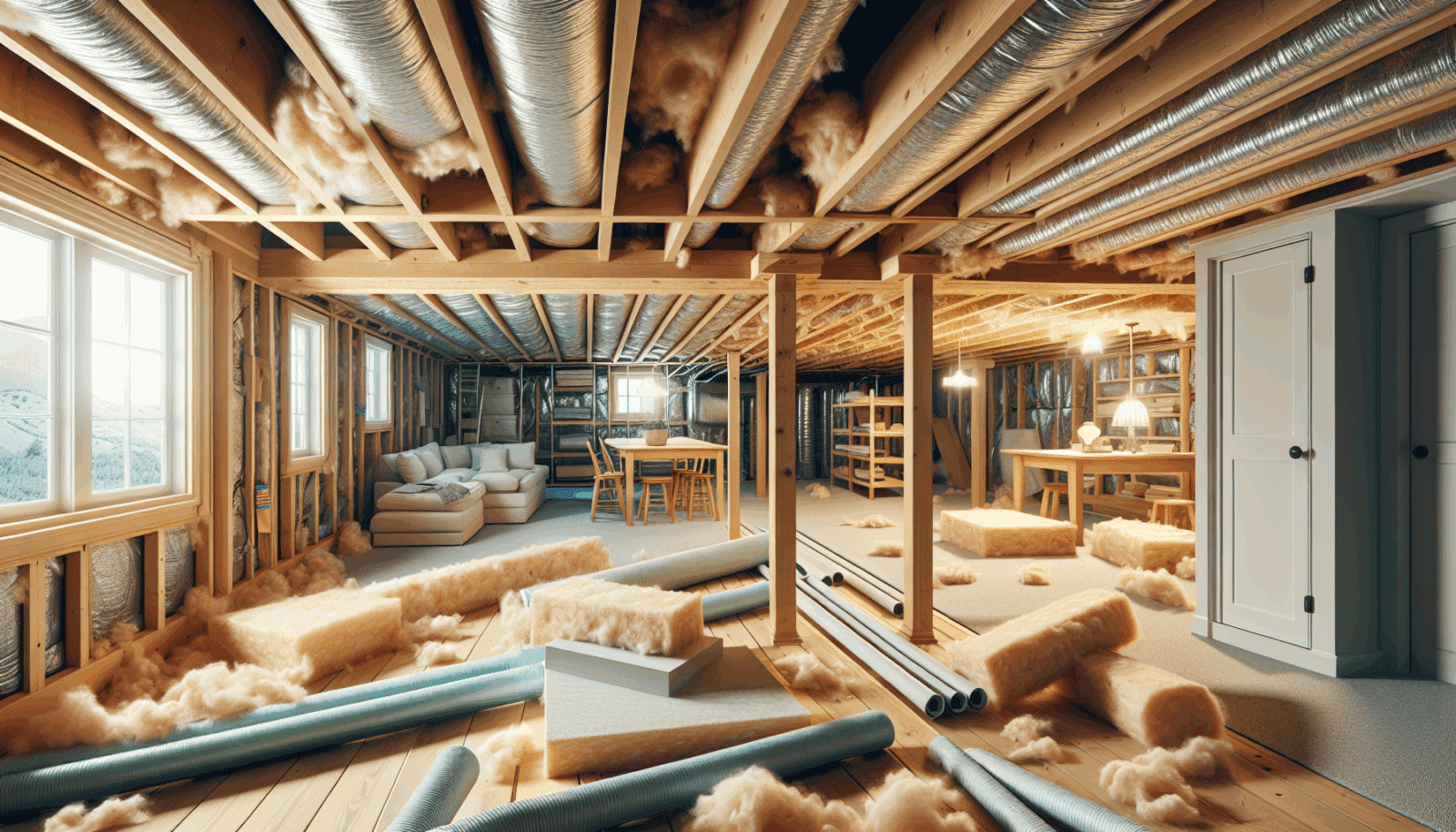If you’re finishing a basement in Salt Lake City, you can’t skip basement insulation. It’s the quiet hero behind warm floors, quieter rooms, and energy bills that don’t make you roll your eyes every January. Utah basements fight a unique battle—cold ground temps, dry air, and sometimes older foundations—so getting the insulation right makes everything else (drywall, flooring, even that future theater room) work better. Let me walk you through it without making it weirdly technical.
Contents
- 1 Why basements in Salt Lake feel cold even when the heat is on
- 2 Start with moisture (because water always wins)
- 3 Wall insulation: foam, fiberglass, or rock wool?
- 4 What about the ceiling? Should you insulate between floors?
- 5 Rim joists: the spot everyone forgets
- 6 Do I need a vapor barrier in Utah?
- 7 Energy code + Salt Lake City reality check
- 8 Common mistakes we see in Utah basements
- 9 Materials we actually like
- 10 So… is it worth it?
- 11 Ready to get your basement insulated the right way?
Why basements in Salt Lake feel cold even when the heat is on
Here’s the thing: basements sit against concrete, and concrete doesn’t care about your comfort. It just absorbs heat. So if your walls or rim joists aren’t insulated, your furnace works harder, your basement stays chilly, and you’re left wondering why “finished basement” still feels like “camping in November.”
On top of that, our climate along the Wasatch Front has big temperature swings. One week it’s 20°F, the next it’s 52°F. A good insulation strategy evens those swings out so your basement doesn’t feel like it has mood swings.
Start with moisture (because water always wins)
This part’s not glamorous, but it’s the make-or-break step. Before stuffing walls with fluffy insulation, check for:
- Past water stains or efflorescence (those white chalky lines on concrete)
- Leaky window wells or weak exterior drainage
- High humidity near the mechanical room
If the foundation wall ever got damp, sealing and correcting that comes first. Insulation over a wet wall = trapped moisture = mold. Not the vibe. Products like foundation sealers, proper gutters, and grading away from the house help you insulate with confidence.
Wall insulation: foam, fiberglass, or rock wool?
This is where people in Utah get stuck. “Do I put studs against concrete? Do I glue foam? Do I need a vapor barrier?” Let me break it down.
1. Rigid foam against concrete (smart and tidy)
A very popular method here is to attach 1–2 inches of rigid foam board (EPS or XPS) directly to the concrete wall. Why? Because foam doesn’t mind a little moisture, and it creates a thermal break between cold concrete and your framing. Then you frame in front of it and add batt insulation between studs. It’s like layering: coat first, sweater second.
2. Fiberglass batts (the classic)
Fiberglass is affordable and easy to install between studs. But fiberglass hates moisture. So it’s best used when the wall has either rigid foam behind it or the foundation is bone dry. A kraft-faced R-13 or R-15 batt inside a 2×4 wall is common and usually meets energy code for a finished basement here.
3. Mineral wool / ROCKWOOL (the tough kid)
Mineral wool is great for basements because it’s moisture-resistant, fire-resistant, and denser—so you also get some sound control. If you’re building a theater room downstairs, this stuff earns its keep.
So which one’s “best”? Honestly, the best system is the one that manages moisture first and thermal loss second. That usually means foam against concrete + batt in the stud wall. Neat, durable, code-friendly.
What about the ceiling? Should you insulate between floors?
Short answer: sometimes. Longer answer: it depends on what you’re trying to do.
If your goal is to keep heat in the basement, insulate the walls first, not the ceiling. But if your goal is to keep sound from traveling upstairs—kids’ gaming room, basement apartment, loud laundry—then insulating the ceiling joists helps. A simple fiberglass batt or mineral wool in the ceiling, plus resilient channels or sound-damping drywall, can make it feel like two separate living areas.
For basement apartments (and I know a lot of people along the I-15 corridor are doing this now), we usually recommend both: wall insulation for comfort, ceiling insulation for privacy.
Rim joists: the spot everyone forgets
That band of wood where your floor system meets the foundation wall—that’s the rim or band joist. And it leaks heat like crazy. If your basement feels drafty, it’s often from this area. The best way to handle it is to cut small pieces of rigid foam to fit in each cavity and seal around them with spray foam, or use a closed-cell spray foam kit. It’s a small detail with a big comfort payoff.
Do I need a vapor barrier in Utah?
Great question—and kind of a trick one. Our climate is semi-arid, but basements are still a moisture-prone space because they’re below grade. Most of the time, rigid foam on the concrete wall acts as your vapor retarder. You don’t want to add a second, tighter plastic layer on the inside that traps moisture.
So the typical stack looks like this:
- Concrete wall
- Rigid foam board (sealed)
- Framed wall with batt insulation
- Drywall
No poly sheeting on the interior side. Let the assembly dry toward the room.
Energy code + Salt Lake City reality check
Salt Lake City and most of the Wasatch Front follow IECC-based energy codes. That’s just a fancy way of saying: basements need to be insulated to keep the heating load down. Most finished basements in our climate zone do well with R-10 continuous (like foam) or R-13 in the wall. If you’re not sure what your city wants, call the building department—they’re actually super helpful here. Or, even easier, let your basement finishing contractor handle it (that’s literally what we do all week).
Common mistakes we see in Utah basements
You know what? Most of the issues we fix come from good intentions. People want to save money and “just frame it up.” But here are the traps:
- Stud wall right against concrete with fiberglass batts—no foam, no gap
- Plastic vapor barrier on the inside trapping moisture
- No insulation on the rim joist
- Skipping sound insulation when planning a basement apartment
- Not treating an exterior walkout wall like an exterior wall
None of those are fatal, but they can cost you comfort and money later.
Materials we actually like
Since you probably want names, here are some solid picks:
- Owens Corning FOAMULAR or similar XPS panels for concrete
- ROCKWOOL Comfortbatt for sound and moisture resistance
- R-13 fiberglass batts for standard framed walls
- Closed-cell spray foam for tricky spots or rim joists
These are things you can find at Home Depot, Lowe’s, or through your contractor—no weird specialty stuff.
So… is it worth it?
Yes. 100%. Properly insulating the basement usually gives you three wins at once: comfort, sound control, and future resale. A finished basement that actually feels like the main level? That’s what buyers want. And it’s what your family wants too—especially in January when the Jazz game is on and nobody wants to sit in a cold room.
Ready to get your basement insulated the right way?
If you’re in Salt Lake City, UT or nearby and you’re planning a basement finish, let us help you pick the right insulation system for your foundation, not just some generic YouTube plan.
By Phone: 801-515-3473




